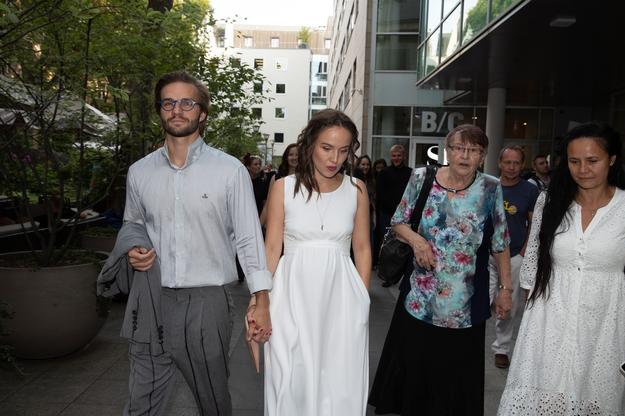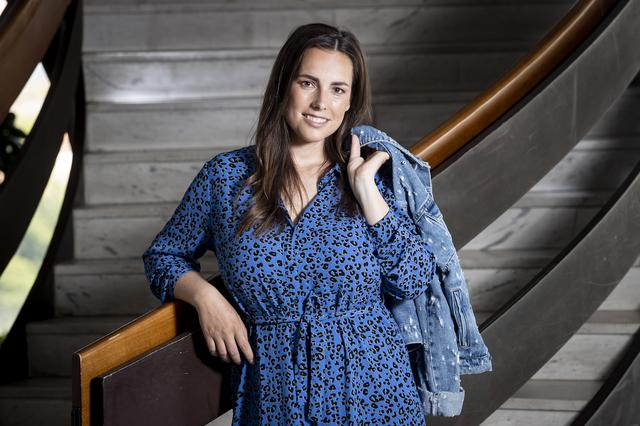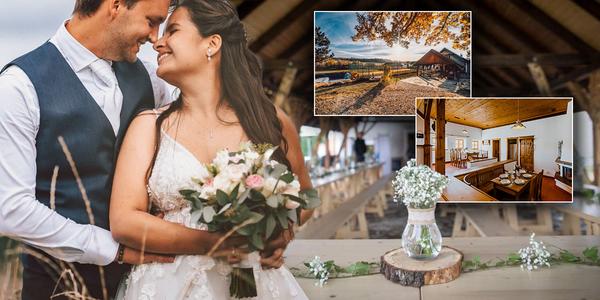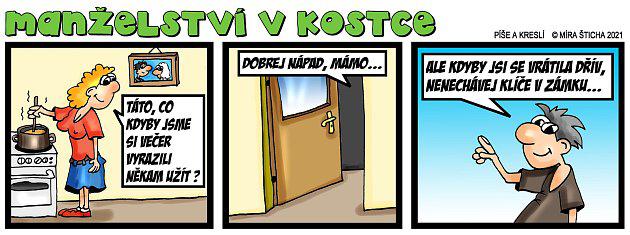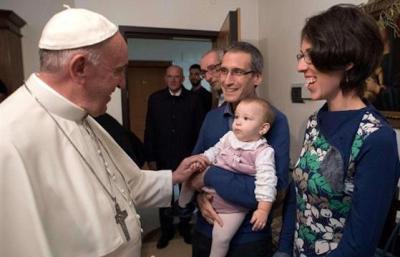Tradition, feminine power and magical meaning. The women coded their embroidery, says the Slovak writer<
Tamara Šimončíková Heribanová is wearing the original woven huipil with floral flat stitch embroidery. It comes from Guatemala in the first half of the 20th century. I came across writer Tamara Šimončíková Heribanová sometime earlier this year on Instagram. I was fascinated by her images full of optimism and positive energy. And also her photos of Slovak folk costumes, which Tamara has been collecting for fifteen years and whose exhibition she organized last year in Bratislava. We have been in active contact since January, although unfortunately we have not seen each other in person. Tamara lives with her husband, photographer Branislav Šimončík and two-year-old daughter Emilka in Portugal, where she researches local folk costumes. Although Tamara invited me to visit Lisbon, I finally made an exception for the first time in the history of Esprit, and we created an opening interview for this issue by e-mail. Since this is a professional interview, about Slovak folk costumes and their meanings, I have a feeling that it doesn't really matter. And I must add that the attentive reader will learn something about Tamara's personality between the lines.
You have been collecting folk costumes for more than fifteen years. When did you become interested in them and why? And do you remember your first costume? The first costume was from my grandmother, with whom I spent my childhood as a child. My grandmother was a teacher, she was born more than eighty years ago in the village of Horná Streda near the spa town of Piešťany. It is a region where the sleeves were characterized by costumes - they were embroidered with sophisticated perforated technology and their production took several months for an experienced embroiderer. During my studies at the grammar school, thanks to a school project, my grandmother and I visited women in the village, who were still involved in bobbin-making and embroidery at the time. During the week they wore work clothes, on Sunday they dressed up in a starched colorful costume and I admired them. Today, these women no longer live and no one wears a costume in the village - except on holidays. Fortunately, many costumes from Horná Streda have been preserved to this day, I have several holiday sets in my collection. And yet their path to me was not easy. When her grandmother was little, she fell ill. My great-grandmother did not have the money to pay for a doctor at the time, so she had to sell the most valuable thing she had overnight - family costumes. Later, my grandmother regained the costumes, but it took them several decades to assemble them.
I know that you have more than thirty costumes in your collection. Can you say which one is your favorite? I assembled some costumes into a complete form for several years, because it is very difficult to get the components so that they are assembled correctly. It is important that the costumes are laid out correctly, no components may be mixed either between the villages or between the categories of individual events for which the costumes are intended. We distinguish between work costumes, then those worn on Sundays and finally those for special events such as holidays. Wedding and funeral costumes also have their specifics. Of course, these are original parts that are over a hundred years old - and some are extremely difficult to find. All of them are rare for me, but the complete holiday costume from the defunct village of Turie Pole is very unique. The village no longer exists, but thanks to the costume, the memory of the masterpiece and the refined aesthetics of its inhabitants remain. I am also grateful to have in my collection a Ruthenian costume from the village of Toryska, which is one of the rarest folk costumes from the East. I also consider the sleeves from the defunct village of Lešť to be a very rare piece. I received them as a gift from a lady living in Munich. She found them cleaning the cellar. I showed them to a friend, a traditional clothing expert Zuzana Tajek Piešová, and she told me that their embroidery carried a certain cipher. The embroidery deliberately dropped the color and replaced it with another - the motif was transformed into another. Logically, this is incomprehensible, for a layman it is a defective pattern. Women sometimes inserted a certain coding into the embroidery that referred to their mental state, which they could not talk to anyone about. For example, if a woman felt great pain or fell in love with another man as a married woman, which is basically similar to pain, she sewed a message about herself into her work. Just as artists, painters, composers, and poets distract the author's subject in the work, so embroiders have transformed their feelings into their work. Let's just take the fact that one piece, one piece of costume, was created for several months. It is not easy to find your way around these characters, many of them we can no longer decipher today. But they exist in embroidery and have their meanings.
You say that assembling a costume is very difficult. Where are the individual parts you are looking for? Are there any bazaars? Or do women already offer them to you? In the years that I have been collecting costumes, I have a large network of contacts in almost all Slovak regions. When I'm missing something, I try to contact costume manufacturers, folklorists to help me get the part. I travel a lot in Slovakia and look directly in the regions. Sometimes mayors also help me. There were times when I walked around bazaars and flea markets, but when I look for a specific part in the collection, it doesn't work anymore. In recent years, I have also been approached by a number of people offering costumes, fragments, embroidery, which they have long maintained. The last time a lady sent me five beautiful books from the interwar period about the development of traditional costumes. These are very rare books with a dedication by their author Bohumil Vavrošek, who documented folk architecture in Czechoslovakia.
Many techniques are used on the costumes… Yes. Podpolaní u Zvolena is proud of crooked needle embroidery, in Horehronie I admire geometry with cross stitch and leather cipher detailed embroidered vests, Piešťany area is characterized by embroidery on the hole and specific bobbin, Liptov with its timeless blueprint is always pleased with colorful crocheted collars. caps very demanding netting technique, so-called non-stitching. For example, small wrinkles and creases are exceptional. Tears welled up in my eyes when I came across more than 150-year-old skirts, called kasanice, from Kopanice in Myjava, which people had burned in many places in the 1980s. Costumes are bearers of wonderful stories - they often hide in the construction of embroidery, color or the way of decoration. For example, women from Lubina tied the tip of the towel up to the left, women from the neighboring village of Bzince pod Javorina to the right. According to this, it was easy to determine from which village the woman came. It was also possible to find out, on the basis of traditional clothing, whether a woman is single, married, pre-married, married, in the first year after marriage, pregnant or in mourning. The fact that the costumes contain a whole system of characters, which can often only be identified within a closed circle of their wearers, I began to find out only through study and interviews with the oldest generation.
Can you describe your collection in more detail? It is currently largely serviced, approved by many local patriots and ethnographers, because I had an exhibition last year and I had to put most of my costumes in order. I soaked the individual parts in vinegar water for hours, washed, bleached in the sun with embroidered embroidery, starched, ironed, sent photos of dressed mannequins to the regions, added information. I compiled accompanying texts and a brief catalog for the exhibition. I confess, I take it very seriously, any mistake is a disgrace to tradition for me. Throughout the show, I waited for a mistake to appear that I would unknowingly make. It didn't happen, people from academia also came to see the exhibition - and this is once again confirmed by what my 92-year-old grandfather once told me: "We people know everything, and if we passed it all on, we would be happy. and wise. ”It means that each of us knows our own, and when we come together, we can do great and important things. In my case, the success of the exhibition, ie its correctness, lay in the fact that people, many, helped me with their knowledge, because it was a common thing. On the day of the opening, many visitors came in traditional costumes. Some traveled for over six hours, because it was something that is ours, what is common and important. It was about maintaining continuity, about passing on knowledge, but it was also about our grandmothers and great-grandmothers, who squinted at the embroidery lamp at the kerosene lamp, which were thrown away ten years ago, because they were just old rags, just a musty branch. And so I looked at the beautifully starched preservers of tradition, at people who came from all over Slovakia, and I was happy that for those months over the yellowed canvas, which was suddenly snow-white on the mannequins, as on the day when it is first dressed our ancestors, they really stood.
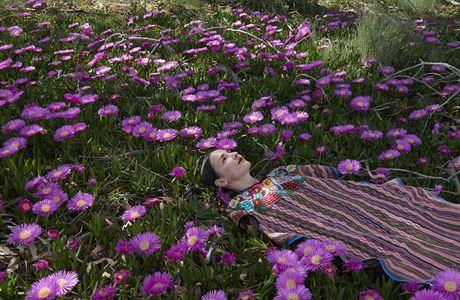
You studied in Austria and Vienna. How has this affected you in relation to Slovak traditions? Today we are seeing an increased interest in folklore, traditions and, of course, folk costumes in Slovakia. But at a time when I began to take the costumes seriously and collect not only the original costumes, but also the stories associated with them, I also encountered cases where people told me that they threw the whole chest of their great-grandmother full of costumes into a container. Even last year, my friend Martin Segeš found several more than a century of richly embroidered sets in Drahovce at the dump. I studied in Austria at primary school, at grammar school and later at university. I attended primary school in a small village in Burgenland and it was only natural that on the day of the report, some of our teachers dressed in Austrian costumes. They chose the most important clothes they had for such an important event. So I grew up in an environment where a certain national awareness was preserved thanks to clothing that is part of cultural heritage and regional identity.
Your dad is a writer, your mother is a presenter. How did the family environment affect you? The environment in which the child grows up is, of course, reflected in his character, taste, interests. It determines what one internally leans towards and what one avoids. My sister and I have never been forcibly led to anything. Our parents let us look for our inner happiness, they created kind conditions for it. We knew what home meant, and we knew its value. In fact, my home, now more hidden in the heart, is strongly connected to my love of traditions. It is an interest in events from the past, in the preservation of memories, testimonies. When we know the mistakes and the right steps of the past, we can move forward more easily. Moreover, there is a lot of wisdom in the sayings, proverbs, in the stories of our grandparents. In my case, it's also curiosity and a sincere affection for anything that would be forgotten. These are small, personal stories that form a whole, part of our DNA.
Are Slovak costumes so demanding to wear as Moravian? Once we photographed the costume and we needed instructions for clothes of all layers. I think the most difficult thing to wear the original costumes is to get some manual on how to dress them properly. If we know the sequence of what, where and how to attach, the dressing itself can be done in an hour or two. The problem, however, is that each village had a different costume with different rules of organization. When we installed the costumes during the preparations for the exhibition, there were also those whose clothes lasted several hours. For example, the costume from old Tekov has ten petticoats, the skirts are lined with hard cardboard, so the wearers could not even sit in the skirt so as not to destroy the paper reinforcement. Even the installation of a tall horned cap full of cinnabar ore was difficult.
Your husband is a fashionable photographer and you and he work with, for example, the fashion magazine Vogue Portugal. What does fashion mean to you? On the one hand, fashion is for me an embodied system of characters. What we wear categorizes us based on a targeted or intuitive selection of clothes. What we wear is part of our identity and affects how we are perceived, ranked and evaluated in society. Fashion and clothing culture is a relatively interesting area for me to interpret, of course in today's social media, influencers and strong patterns, many people are so influenced that sometimes they only wear the perfectly copied style of someone they follow on Instagram. But if the style they copied were not close to them, they would not adopt it. We could say that it is not original, but we live in a time where looking for originality in that purist concept is almost impossible. That is why I am so interested in the tribal culture of clothing and traditional regional clothing, because I find deep originality and true uniqueness there. Then there is the point of view connected with design - clothing is a form of artistic expression, it is a reflection of a certain spirit of the time by fashion designers. For years, I have been supporting and working closely with clothing designers, and I am convinced that where the nation's textile design and clothing are located is closely linked to culture as such.
You're talking about influencers. Did you not notice in your research that women, for example, copy the embroidery of their costumes from each other? Despite the fact that the costume is subject to strict rules, I have also encountered various hybrids and procedures, which I can only explain with assumptions. For example, I came across a costume that came from a particular village and had been in the coffin for decades, but the decorative techniques did not match the location at all. I then learned that the great-grandmother of the costume owner had moved to another village to see her husband, but because she wanted to remember her birthplace, she embroidered the costume with the motifs and techniques used there. She probably taught her neighbors these techniques, such as crooked needle embroidery or beading, because they have since used them on their costumes. Markets and fairs, where people from different villages met, were also very inspiring at that time. It was similar to our trips abroad today.
You now live in Portugal. Do you watch folk costumes, folklore, art motifs there? And what do you tell them, can they be compared to Slovakia? Last summer, I started studying Portuguese regional clothing and costumes. During this week, several-month searches were combined with visits to museums and interviews with anthropologists, ethnographers and custodians. Within the secondary literature, this area in Portugal is absolutely undersized in comparison with Slovakia. On the author's project, which takes place under the Vogue banner, I work with passion and the belief that capturing the stories of craftsmen and direct descendants of the people who created traditional clothing in the country makes a lot of sense. Portuguese costumes bring with them many interesting insights. We recently returned from northern Portugal, the town of Viana do Castelo, home to perhaps the greatest costume specialist from this still very traditional region. Gil Viana spent several days with me in the depositories and explained the specifics of each embroidery. For example, in the past, the bride wore a black costume embroidered with black or silver blown beads. The color black was not the color of sorrow here. The girl wore this costume for the first time when she was suitable for marriage, and sent a handkerchief embroidered with red yarn in a cross technique to the man she intended to marry. If the man showed interest, he accepted the handkerchief and began wearing it tied around his neck - indicating that his heart was already full. The bride later wore the same costume during the wedding and was dressed for the third time when she left. In the south, there was a very interesting costume covering the woman's entire body and face, similar to a burqa, with the difference that the area in the face was covered by a black tunnel resembling a beehive or elephant trunk. However, wearing this costume was banned in the nineteenth century. However, we managed to get one original costume in very poor condition, and now, according to him, one designer is making replicas that we would like to photograph. The cut of the very interesting costume also comes from the Azores, they were coats with a gigantic hood, which was reinforced with a structure made of whale bone. Doing such research is very exciting and challenging at the same time, because we do not have many options where to follow up.
You will now present a project with the Slovak brand MILE in Slovakia, which concerns corner sails. What's going on? I have been collecting the original costumes for over fifteen years, but I approached the magical world of corner sails only after the birth of my daughter Emilie. I will never forget the day I first saw the corner sail. Later that day, I began to search for its function, meaning and symbolism of embroidery. But neither visiting the archives nor working with monographs moved me much further. I slowly began to understand that the corners, as these rare sails were called to protect the mother and newborn, are still shrouded in mystery. At the bazaar, I managed to buy a corner cloth, which the lady sold, thinking it was just an old bedspread. It was a legacy from her mother, who acquired this piece of beautifully embroidered corner sails from her ancestors. A small miracle happened. Suddenly, I was the owner of more than 150-year-old corner sails from Horní Ves near Partizánské, but I also became the bearer of a kind of responsibility to renew interest in the corner. I looked at my linen corner sail, a beautifully embroidered red yarn, which certainly experienced a lot of children's screams and laughter, and in a few hours I spread it out in front of the designers from the Slovak brand MILE, who immediately showed interest in cooperation. We wanted to follow up on the magical aspect of motherhood in the past in Slovakia, while bringing modern, comfortable, quality clothing. In the territory of Slovakia, great attention was paid to this ceremonial and at the same time representative textile in the traditional agricultural environment. The sail sail symbolized the strength of the woman, she was her protective shield. It was believed to protect the life her mother had given this world. The desire for security, joy, and well-being was captured in the thread of the corner, and energy flowed in the protective symbols of her red embroidery, defending both mother and child from the pitfalls. From time immemorial, the corner sail has been associated with the magical protection of women and children from evil forces, bewitching, causing negative thoughts. The practical and magical function of the corner sails was linked to the ritual that took place immediately after the birth: the corner was hung over the bed and needles, pins, nails and a "introduction" - a magic-purification ceremony to end the isolation after the sixth week - behind her mother and baby did not go out. However, in many places in Slovakia, Koutnice was also used for other purposes, such as when a woman was deeply sad. Somewhere, even the woman feeling the coming death wrapped herself in her corner sail, and in peace and embrace, remembering her most beautiful time when her heart was beating as close as possible to her offspring's heart, she let her life end. During the collaboration with the designers from MILE, we used a unique embroidered twig motif for our line from the original saved corner, symbolizing happiness and love in a new life, for both babies and mothers.
In recent years, even big brands have emphasized craftsmanship and tradition. How is Slovakia doing with the tradition of sewing traditional costumes? Do you think this job will last? I think that in Slovakia we are going through a significant wave of interest in folk costumes, folklore and crafts. Thank God there are very honest, experienced costume manufacturers, such as Mrs. Iveta Smileková from Detvan Folk Art, who produces beautiful costumes and embroidery. Mrs. Smileková is an extremely well-known expert, her shop was founded in 1968 at the initiative of her grandmother, the well-known embroiderer and collector Veronika Golianová. To this day, Mrs. Smileková creates costumes that are jewels, valuable not only as a family heritage, but also as a representative attire for events not only of a folk character. In general, however, it is very difficult to get to such a quality canvas, ribbons or components as in the past.
From my childhood and holidays in Slovakia, I remember that women in the villages consistently covered their hair. Why? The headdress has always had extraordinary significance, identifying a woman who was married. As a special clothing part, the cap already existed among the ancient Slavs and is connected with an important part of the traditional wedding ceremony - tapping. After this ceremony, the woman was no longer allowed to go out hairless. In the past, this ban was also supported by ideas about the negative effects of magical forces. It is the hairstyle and the overall design of the woman's head that were the most conservative element in folk clothing during development, until the middle of the last century. The cap protected the woman's head, adorned her and pointed to her position in society, and also revealed her affiliation. The cap was also characterized by the wearer's age, in some villages in Slovakia it was even possible to read the cap as a chronicle, examples are Horehronie caps, so-called hoods. According to their embroidery, it is possible to find out the family affiliation, the occasion when they were worn, the age, condition, number of children. For example, when a woman gave birth to another child, she sewed another square on her hood. In the past, however, the caps were worn not only by married women, but also by so-called sleepers, ie single mothers.
Some time ago you went to a Slovak ball in a beautiful costume - and it attracted a lot of media attention. What do you say to that today? When I first went to the Ball at the Opera in a dress, some of which consisted of over one hundred and fifty-year-old embroidered sleeves from Horná Streda after my great-grandmother with a satin bottle, the reactions were different. Even then, I said that for me, these pieces were haute couture. Two years ago, I went to the Ball at the Opera in a dress that included parts of an interwar costume from the interwar period in Očová. The situation has changed since then, with most accepting the robe very positively. It was interesting that at that time the only negative media response came from the Czech media, where it was written that the costume does not belong to the National Theater. At the same time, it is a traditional holiday dress, according to the protocol equivalent to the evening festive toilet.
Haute couture dresses are extremely expensive. What financial value do costumes cost? As for traditional costumes, I like to talk about their historical and aesthetic value. I don't want to mention a price - it could encourage thieves and all sorts of speculators. I also heard someone visit the grandmothers in the villages with a van and buy de facto their ancestral memories from them for a little money. I don't want to go into details. But I can say that the price of a costume depends on whether it is complete, correctly assembled, in what condition it is and how rare it is. One of my acquaintances bought a costume from the village of Dobrá Niva and the master sent it to him from Pennsylvania. This gentleman living in America makes a living by buying and selling costumes through eBay. And I also once bought a part of the costume that came from Mattapoisett. It was a richly embroidered hat from the village of Drahovce from the beginning of the 20th century. It cost fifteen dollars and I couldn't get it in Slovakia for years.
You are a well-known writer, you have books for children and adults. Aren't you thinking of a book where you can use your knowledge of folklore? I have been taking notes all my life, so I have various interesting stories from the life of a costume collector that I have noted in my notebooks. I don't know if I will incorporate these stories into any prose one day, they are quite curious, but I would definitely enjoy working on this topic in a novel form. At the moment, however, I have a novel written and I am currently making the final edits. It should come out this year.
What does tradition mean to you? That is the theme of this issue of Esprit ... For me, tradition is not just customs, cultural phenomena, the experience of older generations. It's a clue for me that can be learned a lot. It is accepting knowledge and passing it on. It is an important piece of our national identity, a rare part that needs to be preserved and protected.


 Tags:
Tags: Prev
Prev
